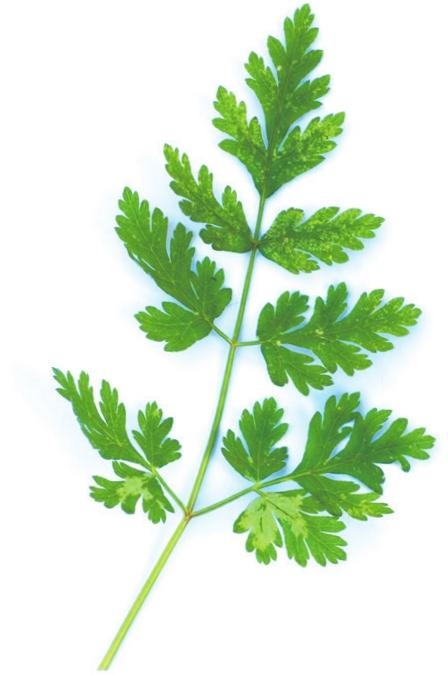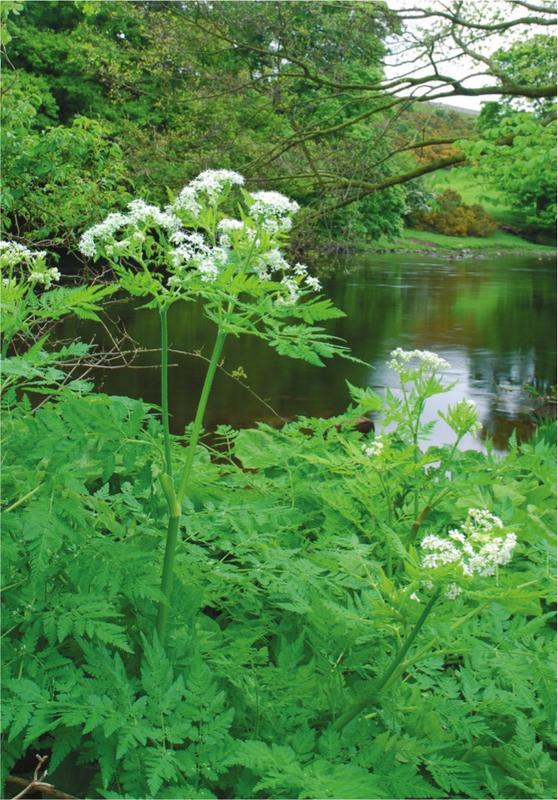Sweet cicely is a common roadside plant in the dales of northern England. The whole plant has a sweet aniseed flavour, giving it many culinary uses. It is traditionally cooked with acid fruit, reducing the amount of sugar needed, and can be used as a sugar substitute by diabetics.
Sweet cicely is a herbal tonic that restores energy, lifts the spirits and settles the digestion.

Apiaceae (Umbelliferae) Carrot family
Description: An aromatic perennial with foamy umbels of creamy white flowers, up to 1m tall.
Habitat: Stream banks, road verges and grassy places.
Distribution: Found primarily in the north and west of Britain and less commonly in north-east Ireland.
Related species: Sweet cicely belongs to a huge family, which includes the common cow parsley but also poisonous species such as hemlock. Sweet cicely is readily identifiable when in flower, and by its aniseed scent when crushed. The leaves usually have distinctive pale blotches.
Parts used: Leaves, flowers, unripe seeds.

Like many herbs, sweet cicely was more widely used in the past than it is now. It was once valued as a protection against infection in the time of plague, and greatly appreciated in salads. Gerard, writing in 1597, said: ‘The seeds eaten as a sallad whiles they are yet green, with oile, vinegar, and pepper, exceed all other sallads by many degrees, both in pleasantnesse of taste, sweetnesse of smell, and wholsomnesse for the cold and feeble stomacke.’ He also liked the leaves in salads, and said that the boiled roots are not only tasty but very good for old people.
Use sweet cicely for…
Sweet cicely still tastes just as good as it did all those years ago. It stimulates the appetite, relieves flatulence, griping and indigestion, and lifts the spirits. The whole plant is edible, and as Culpeper said: ‘It is so harmless, you cannot use it amiss.’
Try the fresh young leaves, at their best before the plant flowers, chopped in salads. They can be used as a flavouring in cooking both sweet and savoury dishes. Add the flowers to salads and desserts, or use as a garnish. The green unripe seeds can be nibbled to stimulate the appetite or to settle indigestion or gas and griping. They have a stronger flavour than the leaves or flowers. The young stems can be eaten too.

Medicinally it has many virtues and few vices – so few that from the Greeks onwards it was seen as a plant that could not be overused. – Furnell (1985)
Sweet cicely is particularly good for older people who have lost their enthusiasm for life, as it lifts the spirits and enkindles the digestive fire. It enables them to enjoy their food with good appetite, warming the digestion and improving absorption of nutrients.
This plant is also beneficial for anyone who is weak or exhausted, perhaps after a chronic illness or through caring for someone else. It will help them get back their energy and joie de vivre, slowly rebuilding their strength and gently warming the whole system.
Sweet cicely apéritif
This can be drunk before meals to stimulate the appetite, or used as an after-dinner drink to settle the digestion. It can also be taken purely medicinally for flatulence, colic or griping pains.
Use either a handful of green sweet cicely seeds or several handfuls of leaves and stems. Chop them up and put into a large, clean glass jar.
Add about 500ml of vodka, and let steep in a dark place for two or three days. Taste it to check that the flavour of the herb has been absorbed by the alcohol, then strain and bottle in a clean glass bottle. The flavour improves if the bottle is left to age for two months in a dark place at room temperature before using.

(This and previous two pages) Sweet cicely in the North Yorkshire dales, May